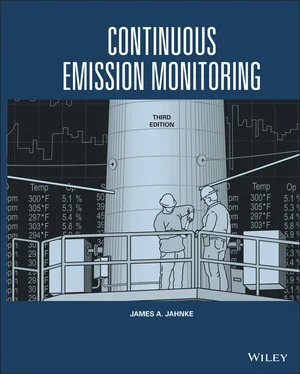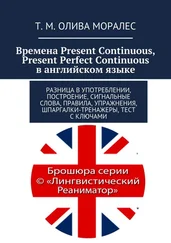James A. Jahnke - Continuous Emission Monitoring
Здесь есть возможность читать онлайн «James A. Jahnke - Continuous Emission Monitoring» — ознакомительный отрывок электронной книги совершенно бесплатно, а после прочтения отрывка купить полную версию. В некоторых случаях можно слушать аудио, скачать через торрент в формате fb2 и присутствует краткое содержание. Жанр: unrecognised, на английском языке. Описание произведения, (предисловие) а так же отзывы посетителей доступны на портале библиотеки ЛибКат.
- Название:Continuous Emission Monitoring
- Автор:
- Жанр:
- Год:неизвестен
- ISBN:нет данных
- Рейтинг книги:4 / 5. Голосов: 1
-
Избранное:Добавить в избранное
- Отзывы:
-
Ваша оценка:
- 80
- 1
- 2
- 3
- 4
- 5
Continuous Emission Monitoring: краткое содержание, описание и аннотация
Предлагаем к чтению аннотацию, описание, краткое содержание или предисловие (зависит от того, что написал сам автор книги «Continuous Emission Monitoring»). Если вы не нашли необходимую информацию о книге — напишите в комментариях, мы постараемся отыскать её.
The new edition of the only single-volume reference on both the regulatory and technical aspects of U.S. and international continuous emission monitoring (CEM) systems Continuous Emission Monitoring
Continuous Emission Monitoring:
Continuous Emission Monitoring, Third Edition
Continuous Emission Monitoring — читать онлайн ознакомительный отрывок
Ниже представлен текст книги, разбитый по страницам. Система сохранения места последней прочитанной страницы, позволяет с удобством читать онлайн бесплатно книгу «Continuous Emission Monitoring», без необходимости каждый раз заново искать на чём Вы остановились. Поставьте закладку, и сможете в любой момент перейти на страницу, на которой закончили чтение.
Интервал:
Закладка:
8 Gill, A. (1993). The BIF regulations applied to the cement industry. In: Proceedings – Continuous Emission Monitoring – A Technology for the 90s, 111–117. Pittsburgh: Air & Waste Management Association.
9 India – Central Pollution Control Board (CPCP) (2018). Guidelines for Continuous Emission Monitoring Systems. Revision‐01. Delhi, India. Central Pollution Control Board. http://www.indiaenvironmentportal.org.in(accessed 12 November 2021).
10 Indiana Department of Environmental Management (IDEM) (2017). Compliance Branch Guidance Manuals. CEMS/COMS, Forms and Information and Guidance. Indiana Department of Environmental Management Office of Air Quality – Compliance. https://www.in.gov/idem/airquality(accessed 12 November 2021).
11 Jahnke, J.A., Peeler, J.W., Juneau, P.J., and Kinner, L.L. (1997). Handbook – Continuous Emission Monitoring Systems for Non‐criteria Pollutants. EPA/625/R‐97/001. Environmental Protection Agency.
12 Lillis, E.J. and Schueneman, J.J. (1975). Continuous emission monitoring: objectives and requirements. Journal of the Air Pollution Control Association 25: 804–809.
13 Lowery, K.P. and Facca, G.L. (1997). The effect of the proposed use of any credible evidence to determine compliance on utilities. In: Proceedings – Specialty Conference on Acid Rain and Electric Utilities II (ed. P. Dayal), 297–304. Pittsburgh: Air & Waste Management Association.
14 McCoy, P.G., Boone, S., Dincer, T. et al. (1996). Statistical review of U.S. EPA Region 5's CEM database. In: Proceedings – Continuous Compliance Monitoring Under the Clean Air Act Amendments, 223–234. Pittsburgh: Air & Waste Management Association.
15 Nazzaro, J.G. (1985). Continuous emission monitoring system approval, auditing and data processing in the Commonwealth of Pennsylvania. In: Transactions – Continuous Emission Monitoring – Advances and Issues, 175–186. Pittsburgh: Air Pollution Control Association.
16 New Jersey Department of Environmental Protection (2010). Guidelines for Continuous Emissions Monitoring System (CEMS), Continuous Opacity Monitoring Systems (COMS), Periodic Monitoring Procedures (PMPS), and Annual Combustion Adjustments (ACAs). Technical Manual #1005. New Jersey Department of Environmental Protection – Air Quality Permitting Program Bureau of Technical Services. https://www.state.nj.us/dep/aqpp/techman.html(accessed 12 November 2021).
17 Paley, L.R. (1980). Agency use of continuous emission monitoring data to ensure stationary source achievement of emission reductions. Paper presented at Air Pollution Control Association, Montreal, paper 80‐70.1 (22–27 June 1980).
18 Paley, L.R. and Wright, H. (1985). Use of continuous emission monitoring systems to implement EPA's continuous compliance program. In: Transactions – Continuous Emission Monitoring – Advances and Issues (ed. J.A. Jahnke), 128–145. Pittsburgh: Air Pollution Control Association.
19 Pennsylvania Department of Environmental Protection (PADEP) (2006). Continuous Source Monitoring Manual – Revision 8. 274‐030‐001. Pennsylvania Department of Environmental Protection. https://www.dep.pa.gov(accessed 12 November 2021).
20 U.S. Environmental Protection Agency (1984). Final technical guidance on the review and use of excess emission reports: E.E. Reich to Regional Office Directors. EPA Air Programs Policy and Guidance Notebook, Policy Notebook Number PN 113‐84‐10‐05‐021. Research Triangle Park: Office of Air Quality Planning and Standards.
21 U.S. Environmental Protection Agency (1994). The Continuous Emission Monitoring Guidance for Part 503 Sewage Sludge Incinerators. EPA 833‐B‐94‐003. Washington, DC: Environmental Protection Agency, Office of Water.
22 U.S. Environmental Protection Agency (2014). Revision of U.S. Environmental Protection Agency’s Enforcement Response Policy for High Priority Violations of the Clean Air Act. https://www.epa.gov/sites/production/files/2015‐01/documents/hpvpolicy2014.pdf(accessed 12 November 2021).
23 Vermont Air Quality and Climate Division (2002). Continuous Emission Monitoring Regulations – Revision 5. Vermont Department of Environmental Conservation. https://www.dec.vermont.gov(accessed 12 November 2021).
24 Walton, J.W., Stewart, J.W., and Singleton, F.O. (1985). Utilization of continuous emission monitoring data for enforcement purposes. In: Transactions – Continuous Emission Monitoring – Advances and Issues (ed. J.A. Jahnke), 199–207. Pittsburgh: Air Pollution Control Association.
25 Westlin, P.R. and Balcke, W.W. (1997). Compliance assurance monitoring rule – status of final rulemaking. Paper presented at the Air & Waste Management Meeting, Toronto, paper 97‐TA37.01 (8–13 June 1997).
26 Willenberg, J.M. (1990). Washington State's CEMS experience and enforcement guidance. In: Proceedings – Specialty Conference on: Continuous Emission Monitoring – Present and Future Applications, 37–43. Pittsburgh: Air & Waste Management Association.
27 Williams, B. and Jahnke, J.A. (1994). Protocols and performance specifications for continuous monitoring of gaseous emissions from thermal power generation. Electricity Today 6 (6): 16–18.
28 Zipper, C.E. and Gilroy, L. (1998). Sulfur dioxide emissions and market effects under the clean air act acid rain program. Journal of the Air & Waste Management Association 48: 829–837.
CHAPTER 3 EXTRACTIVE SYSTEM DESIGN
Analyzers used to monitor stack gases must be incorporated into a system – one that can protect the analyzer from the plant environment and provide a representative stack gas sample for analysis. Either in‐situ or extractive systems can be designed to perform this. Extractive systems were the systems first developed for continuous emission monitoring and are discussed in this chapter; in‐situ systems are discussed in Chapter 6.
Delivering and conditioning a hot, moisture‐saturated, particle‐laden flue gas to an analyzer can be a difficult process. Because the pollutant gases may be lost in this process, it is critical that the extractive system is properly designed and manufactured. Extractive system designs are associated with specific CEM system vendors, having been developed through years of industrial applications experience. Although it is possible and relatively easy to design and construct an extractive system from basic components, most systems purchased today are provided on a turn‐key basis; that is, the system is provided from start to finish. The two basic types of extractive systems that vendors offer are (i) fully extractive, source‐level systems and (ii) dilution systems. Each system has its own advantages and disadvantages in any given application.
This chapter describes both source‐level and dilution extractive systems and the components that are used in their design. Knowledge of these extractive techniques will assist in evaluating proposed system designs or systems that have already been installed.
SOURCE‐LEVEL EXTRACTIVE SYSTEMS
Source‐level extractive systems remove gas directly from the stack or duct, filter out particulate matter, and transport the gas for analysis. Three types of source‐level extractive systems are marketed commercially:
1 Hot/wet systems ( Figure 3‐1)
2 Cool/dry systems with conditioning at the probe ( Figure 3‐2)
3 Cool/dry systems with conditioning at the CEM system shelter ( Figure 3‐3)
Hot/Wet Systems
The simplest type of extractive system uses a heated line to transport the flue gas to an analyzer that incorporates a sample cell heated above the flue gas temperature. The gas is delivered to the analyzer both hot and wet, but it minimally conditions the gas by removing particulate matter with a coarse filter located at the probe. The technique is useful when monitoring of water‐soluble gases is required, or when wet‐basis emission values are to be reported. Because water is not removed from the sample gas, problems associated with condensation systems are avoided. However, care must be exercised in maintaining the temperature of the sample above the dew point, from the probe to the analyzer exhaust. If the heating system should fail, moisture will readily condense and foul the system. This can lead to corrosion, plugging, or damage to the analyzer. Accordingly, a hot/wet system must be designed to shut down and flush with clean, dry air or nitrogen in case the system begins to cool down due to an event such as a power outage or heater failure.
Читать дальшеИнтервал:
Закладка:
Похожие книги на «Continuous Emission Monitoring»
Представляем Вашему вниманию похожие книги на «Continuous Emission Monitoring» списком для выбора. Мы отобрали схожую по названию и смыслу литературу в надежде предоставить читателям больше вариантов отыскать новые, интересные, ещё непрочитанные произведения.
Обсуждение, отзывы о книге «Continuous Emission Monitoring» и просто собственные мнения читателей. Оставьте ваши комментарии, напишите, что Вы думаете о произведении, его смысле или главных героях. Укажите что конкретно понравилось, а что нет, и почему Вы так считаете.












